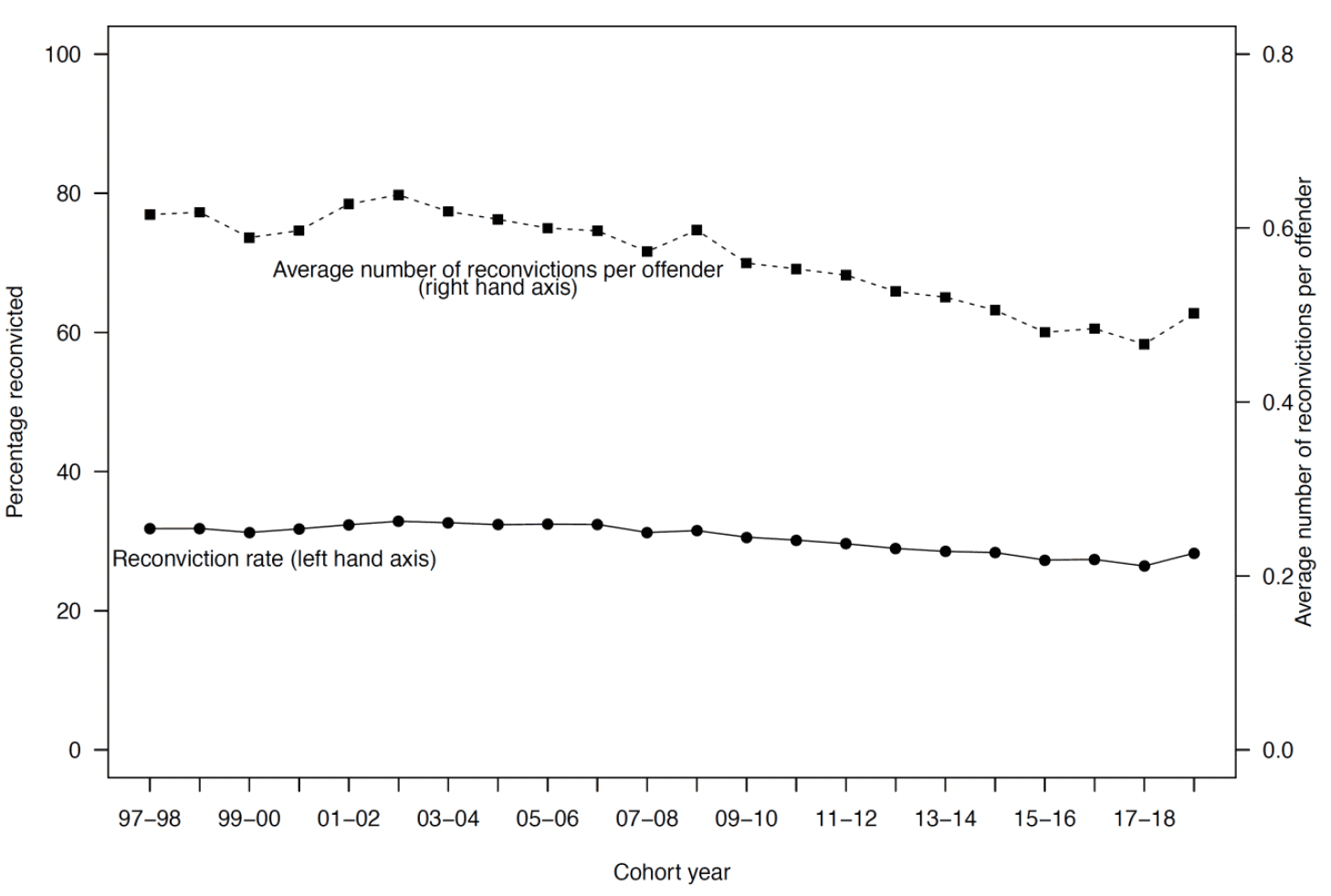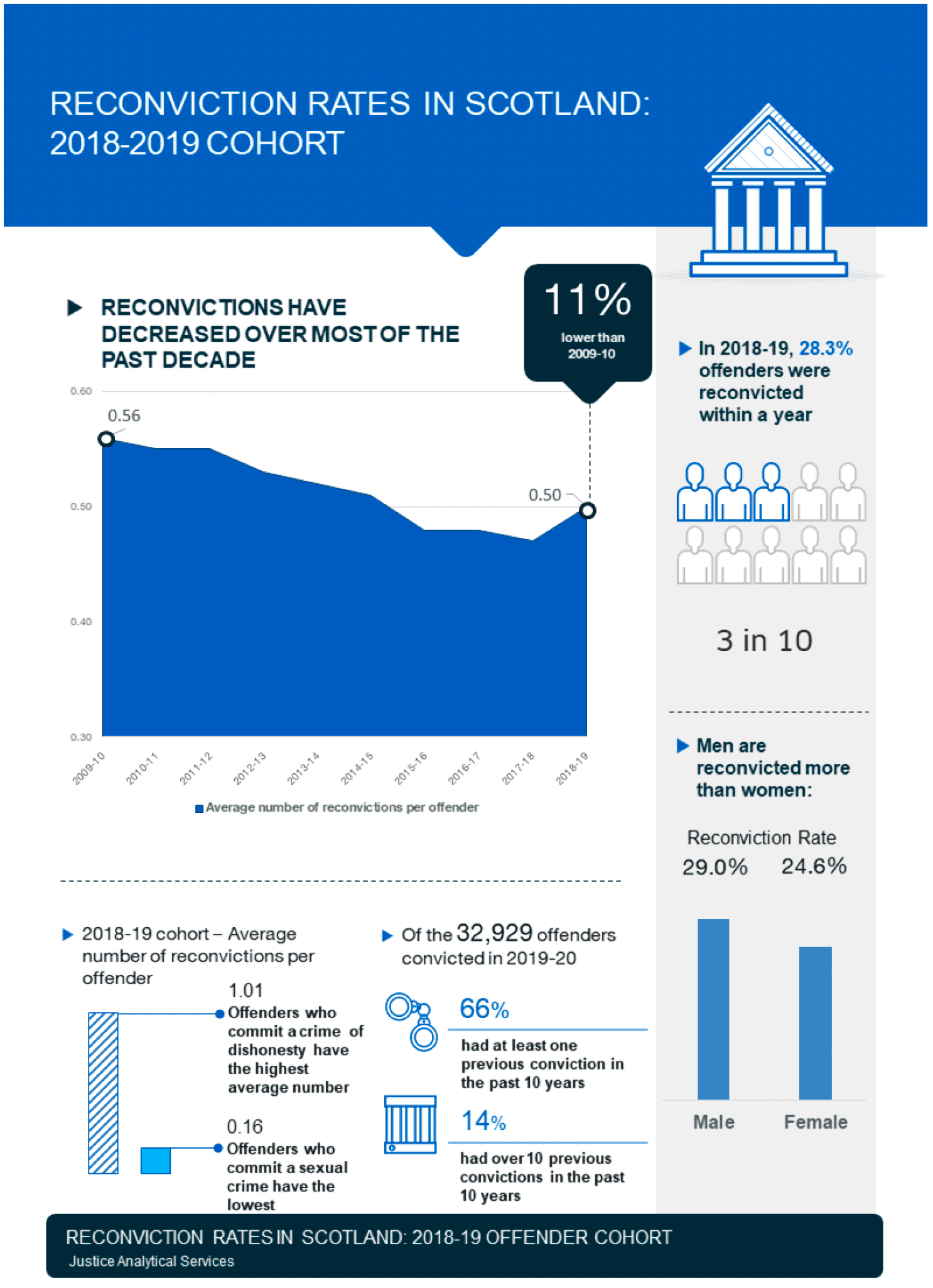Reconviction Rates in Scotland: 2018-19 Offender Cohort
Analyses of trends in reconviction statistics up to the latest cohort of 2018-19.
Key points
Statistics are presented on the number of individuals who were released from a custodial sentence or given a non-custodial sentence in 2018-19 and then subsequently reconvicted within a year, along with selected trends. Note that the period covered by this bulletin is prior to the COVID-19 pandemic.
The reconviction rate, which is the percentage of offenders who are reconvicted in a year, was 28.3% in 2018-19. This is a 1.9 percentage point increase from 26.4% in 2017-18. The average number of reconvictions per offender, a measure of how often offenders are reconvicted, increased by 6% in the same period from 0.47 to 0.50. See Chart 1 and Table 1.


- The reconviction rate increased by 1.9 percentage points over the last year from 26.4% in 2017-18 to 28.3% in 2018-19. The average number of reconvictions per offender increased by 6% in the same period from 0.47 to 0.50 (Table 1).
- There were increases in both measures of reconvictions over the past year across many of the different groupings presented in this bulletin.
- The increase in the reconviction rate and average number of reconvictions per offender is contrary to the decreases seen in most years over the past decade. However, the most recent figures are still lower than those ten years ago. Over the ten years between 2009-10 and 2018-19, the reconviction rate has fallen by 2.3 percentage points from 30.6% to 28.3%, and the average number of reconvictions per offender has decreased by 11% from 0.56 to 0.50 (Table 1).
- Males are reconvicted more often, on average, than females. In 2018-19, the average number of reconvictions per offender for males was 0.51, which was 6% higher than the value of 0.48 for females (Table 2).
- Almost all age-sex combinations saw an increase in both measures of reconvictions in the past year (Table 4 and Table 5).
- As in previous years, offenders who committed a crime of dishonesty had the highest reconviction rate (45.6% in 2018-19), compared to offenders that committed another type of crime. Offenders who committed a sexual crime had the lowest (10.4% in 2018-19) (Table 6).
- 6.9% of offenders with an index domestic abuse crime or offence in 2018-19 were reconvicted for a further domestic abuse crime or offence (Table 8a), and 17.7% were reconvicted for any crime or offence.
- Offenders released from a custodial sentence had an average number of reconvictions per offender of 0.81 in 2018-19, which was 2% higher than 0.79 in 2017-18 (Table 9). Short custodial sentences have higher reconvictions than longer sentences. Offenders given shorter sentences commit relatively less serious crimes, and tend to commit more of these crimes than those committing more serious crimes; and also do not have the opportunity to engage in rehabilitative work whilst in custody. Therefore, they are reconvicted more often. In 2018-19 the average number of reconvictions per offender for custodial sentences of three months or less was 1.22, compared to 0.09 for those over four years (Table 10a).
- Community Payback Orders (CPOs) are the most commonly used community sentence. Unlike most other disposals, where reconvictions have increased in the past year, there has been little change for CPOs. The reconviction rate was 29.2% in 2018-19, which was the same as in 2017-18. The average number of reconvictions per offender for CPOs was 0.51 in 2018-19, which was slightly lower than 0.52 in 2017-18 (Table 9).
- 18% of individuals given a non-court disposal by the police in 2018-19 (such as a warning or fine), and 15% of individuals given a non-court disposal by the Crown Office and Procurator Fiscal Service, received another non-court disposal within a year (Table 19).
Contact
Email: Justice_Analysts@gov.scot
There is a problem
Thanks for your feedback